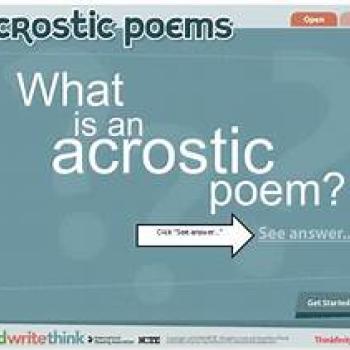Acrostic Poems

About this Interactive
Overview
In this online tool, students can learn about and write acrostic poems. An acrostic poem uses the letters in a word to begin each line of the poem. All lines of the poem relate to or describe the main topic word. As part of the online tool, students brainstorm words to help write their poems and can save their work-in-progress to revise and edit, reinforcing elements of the writing process. Students can also print their finished acrostic poems or proudly show off their work by e-mailing it to a friend.
Related Resources
- Student Interactives |
- Calendar Activities |
- Printouts |
- Lesson Plans
This online tool enables students to learn about and write diamante poems.
Formerly known as Shape Poems, this online tool allows elementary students to write poems in various shapes.
Students are assigned to be "poets of the day" and are provided several models to create, illustrate, and present their different poems to the class.
Students select a poem and create a Stapleless Book using the interactive tool.
Students read and respond to Billy Collins' poem "Introduction to Poetry." Students then write about a favorite poem and imagine the perfect way to read it.
Students research engineering careers and create poetry to understand the vocabulary of STEM (science, technology, engineering, and mathematics).
Students compare the sinking of the Edmund Fitzgerald with the song, "The Wreck of the Edmund Fitzgerald," then create their own poetry about a historical event.
Students create acrostic poems using their names and the names of things that are important to them.
Students apply think-aloud strategies to reading and to composition of artwork and poetry. They research symbols of peace as they prewrite, compose, and publish their poetry.
What do your students think about each other? Find out as you teach them the concepts of acrostic poems and challenge them to write an uplifting acrostic about a classmate.
Introduce gerunds and review nouns, adjectives, and verbs through engaging read-alouds; then apply these concepts through collaborative word-sorting and poetry-writing activities.
Studied students stupefy! Students learn about alliteration by listening to an alliterative read-aloud and apply the knowledge they gain to the creation of their own poem and illustration.
Students learn about alliteration, and then practice using alliteration in acrostic poems, tongue twisters, alphabet books, and number books.
Shadows, shadows, everywhere! In this lesson, students read fiction, informational text, and poetry about shadows to extend their knowledge of the concept before casting their own shadow poetry.
Students shape up their reading, writing, and listening skills in this lesson by creating original diamante, acrostic, and shape poems about science.
In this lesson, students explore ekphrasis—writing inspired by art. Students find pieces of art that inspire them and compose a booklet of poems about the pieces they have chosen.
Pat Mora's poem "Echoes" demonstrates that our senses are powerful tools for literary analysis and comprehension as students use their senses to discover new ways to read and write.